
Callovian
Encyclopedia
In the geologic timescale, the Callovian is an age or stage in the Middle Jurassic
, lasting between 164.7 ± 4.0 Ma (million years ago) and 161.2 ± 4.0 Ma. It is the last stage of the Middle Jurassic
, following the Bathonian
and preceding the Oxfordian.
in 1852. Its name derives from the latin
ized name for Kellaways Bridge, a small hamlet 3 km north-east of Chippenham
, Wiltshire
, England
.
The base of the Callovian is defined as the place in the stratigraphic column where the ammonite
genus
Kepplerites
first appears, which is the base of the biozone
of Macrocephalites herveyi
. A global reference profile (a GSSP) for the base had in 2009 not yet been assigned.
The top of the Callovian (the base of the Oxfordian) is at the first appearance of ammonite species Brightia thuouxensis.
 The Callovian is often subdivided into three substages (or subages): Lower/Early, Middle and Upper/Late Callovian. In the Tethys domain
The Callovian is often subdivided into three substages (or subages): Lower/Early, Middle and Upper/Late Callovian. In the Tethys domain
, the Callovian encompasses six ammonite biozones:
was an Archipelago
of a dozen or so large islands. Between them were extensive areas of continental shelf
. Consequently, there are shallow marine Callovian deposits in Russia and from Belarus, through Poland and Germany, into France and eastern Spain and much of England. Around the former island coasts are frequently, land-derived sediments. These are to be found, for example, in western Scotland.
The Louann Salt
and the southern Campeche Salt of the Gulf of Mexico
are thought to have formed by an embayment of the Pacific Ocean across modern-day Mexico.
†Ammonitida
Members of the Order Ammonitida are known as ammonitic ammonites. They are distinguished primarily by their suture
lines. In ammonitic suture patterns, the lobes and saddles are much subdivided (fluted) and subdivisions are usually rounded instead of saw-toothed. Ammonoids of this type are the most important species from a biostratigraphical point of view. This suture type is characteristic of Jurassic
and Cretaceous
ammonoids but extends back all the way to the Permian
.
.; 1842: Paléontologie française. 1. Terrains oolitiques ou jurassiques. 642 p, Bertrand, Paris.
Middle Jurassic
The Middle Jurassic is the second epoch of the Jurassic Period. It lasted from 176-161 million years ago. In European lithostratigraphy, rocks of this Middle Jurassic age are called the Dogger....
, lasting between 164.7 ± 4.0 Ma (million years ago) and 161.2 ± 4.0 Ma. It is the last stage of the Middle Jurassic
Middle Jurassic
The Middle Jurassic is the second epoch of the Jurassic Period. It lasted from 176-161 million years ago. In European lithostratigraphy, rocks of this Middle Jurassic age are called the Dogger....
, following the Bathonian
Bathonian
In the geologic timescale the Bathonian is an age or stage of the Middle Jurassic. It lasted from approximately 167.7 Ma to around 164.7 Ma...
and preceding the Oxfordian.
Stratigraphic definitions
The Callovian stage was first described by French palaeontologist Alcide d'OrbignyAlcide d'Orbigny
Alcide Charles Victor Marie Dessalines d'Orbigny was a French naturalist who made major contributions in many areas, including zoology , palaeontology, geology, archaeology and anthropology....
in 1852. Its name derives from the latin
Latin
Latin is an Italic language originally spoken in Latium and Ancient Rome. It, along with most European languages, is a descendant of the ancient Proto-Indo-European language. Although it is considered a dead language, a number of scholars and members of the Christian clergy speak it fluently, and...
ized name for Kellaways Bridge, a small hamlet 3 km north-east of Chippenham
Chippenham, Wiltshire
Chippenham is a market town in Wiltshire, England, located east of Bath and west of London. In the 2001 census the population of the town was recorded as 28,065....
, Wiltshire
Wiltshire
Wiltshire is a ceremonial county in South West England. It is landlocked and borders the counties of Dorset, Somerset, Hampshire, Gloucestershire, Oxfordshire and Berkshire. It contains the unitary authority of Swindon and covers...
, England
England
England is a country that is part of the United Kingdom. It shares land borders with Scotland to the north and Wales to the west; the Irish Sea is to the north west, the Celtic Sea to the south west, with the North Sea to the east and the English Channel to the south separating it from continental...
.
The base of the Callovian is defined as the place in the stratigraphic column where the ammonite
Ammonite
Ammonite, as a zoological or paleontological term, refers to any member of the Ammonoidea an extinct subclass within the Molluscan class Cephalopoda which are more closely related to living coleoids Ammonite, as a zoological or paleontological term, refers to any member of the Ammonoidea an extinct...
genus
Genus
In biology, a genus is a low-level taxonomic rank used in the biological classification of living and fossil organisms, which is an example of definition by genus and differentia...
Kepplerites
Kepplerites
Kepplerites is a moderately evolute ammonite from the lower Callovian included in the Stephanocerataceae.Inner whorls are finely ribbed and have a flattened or grooved venter, the outer whorl has a rounded venter with smooth ribs that cross from side to side without interruption.Kepplerites is...
first appears, which is the base of the biozone
Biozone
Biostratigraphic units or Biozones are intervals of geological strata that are defined on the basis of their characteristic fossil taxa....
of Macrocephalites herveyi
Macrocephalites
Macrocephalites is a genus of the stephanoceratacean ammonite family Macrocephalitidae, diagnostic of the Callovian stage of the Middle Jurassic...
. A global reference profile (a GSSP) for the base had in 2009 not yet been assigned.
The top of the Callovian (the base of the Oxfordian) is at the first appearance of ammonite species Brightia thuouxensis.
Subdivision

Tethys Ocean
The Tethys Ocean was an ocean that existed between the continents of Gondwana and Laurasia during the Mesozoic era before the opening of the Indian Ocean.-Modern theory:...
, the Callovian encompasses six ammonite biozones:
- zone of Quenstedtoceras lamberti
- zone of Peltoceras athletaPeltocerasPeltoceras is an extinct ammonite genus from the aspidoceratid subfamily Peltoceratinae that lived during the later part of the Middle Jurassic ....
- zone of Erymnoceras coronatum
- zone of Reineckeia anceps
- zone of Macrocephalites gracilis
- zone of Bullatimorphites bullatus
Palaeogeography
During the Callovian, EuropeEurope
Europe is, by convention, one of the world's seven continents. Comprising the westernmost peninsula of Eurasia, Europe is generally 'divided' from Asia to its east by the watershed divides of the Ural and Caucasus Mountains, the Ural River, the Caspian and Black Seas, and the waterways connecting...
was an Archipelago
Archipelago
An archipelago , sometimes called an island group, is a chain or cluster of islands. The word archipelago is derived from the Greek ἄρχι- – arkhi- and πέλαγος – pélagos through the Italian arcipelago...
of a dozen or so large islands. Between them were extensive areas of continental shelf
Continental shelf
The continental shelf is the extended perimeter of each continent and associated coastal plain. Much of the shelf was exposed during glacial periods, but is now submerged under relatively shallow seas and gulfs, and was similarly submerged during other interglacial periods. The continental margin,...
. Consequently, there are shallow marine Callovian deposits in Russia and from Belarus, through Poland and Germany, into France and eastern Spain and much of England. Around the former island coasts are frequently, land-derived sediments. These are to be found, for example, in western Scotland.
The Louann Salt
Louann Salt
The Louann Salt is a widespread evaporite formation that formed in the Gulf of Mexico during the Callovian in the mid Jurassic. The Louann formed in a rift as the South American and North American Plates separated, from an embayment of the Pacific Ocean...
and the southern Campeche Salt of the Gulf of Mexico
Gulf of Mexico
The Gulf of Mexico is a partially landlocked ocean basin largely surrounded by the North American continent and the island of Cuba. It is bounded on the northeast, north and northwest by the Gulf Coast of the United States, on the southwest and south by Mexico, and on the southeast by Cuba. In...
are thought to have formed by an embayment of the Pacific Ocean across modern-day Mexico.
Crocodylomorphs
| Crocodylomorphs of the Callovian | ||||
|---|---|---|---|---|
| Taxa | Presence | Location | Description | Images |
| Junggarsuchus Junggarsuchus Junggarsuchus is an extinct genus of sphenosuchian crocodylomorph from the Middle Jurassic of China. The type species is J. sloani.-Anatomy:... |
The sphenosuchia Sphenosuchia Sphenosuchia is a suborder of basal crocodylomorphs that first appeared in the Triassic and occurred into the Late Jurassic. Most were small, gracile animals with an erect limb posture. They are now thought to be ancestral to crocodyliforms, which include all living crocodilians.-Stratigraphic... n Junggarsuchus was a small, ~1 meter long, Chinese China Chinese civilization may refer to:* China for more general discussion of the country.* Chinese culture* Greater China, the transnational community of ethnic Chinese.* History of China* Sinosphere, the area historically affected by Chinese culture... predator. |
 |
||
| Metriorhynchus Metriorhynchus Metriorhynchus is an extinct genus of marine crocodyliform that lived in the oceans during the Middle to Late Jurassic. Metriorhynchus was named by the German palaeontologist Christian von Meyer in 1830. Metriorhynchus was a carnivore that spent much, if not all, its life out at sea... |
An opportunistic carnivore Carnivore A carnivore meaning 'meat eater' is an organism that derives its energy and nutrient requirements from a diet consisting mainly or exclusively of animal tissue, whether through predation or scavenging... that fed on fish Fish Fish are a paraphyletic group of organisms that consist of all gill-bearing aquatic vertebrate animals that lack limbs with digits. Included in this definition are the living hagfish, lampreys, and cartilaginous and bony fish, as well as various extinct related groups... , belemnites and other marine animals and possible carrion. Metriorhynchus grew to an average adult length of 3 meters (9.6 ft), although some individuals may have reached lengths rivaling those of large nile crocodile Nile crocodile The Nile crocodile or Common crocodile is an African crocodile which is common in Somalia, Ethiopia, Uganda, Kenya, Egypt, Tanzania, Zambia, Zimbabwe, Gabon, South Africa, Malawi, Sudan, Botswana, and Cameroon... s. |
|||
| Steneosaurus Steneosaurus Steneosaurus is an extinct genus of teleosaurid crocodyliform from the Early Jurassic to Early Cretaceous . Fossil specimens have been found in England, France, Germany, Switzerland and Morocco.-Species:... |
||||
†Ornithischians
| Ornithischia Ornithischia Ornithischia or Predentata is an extinct order of beaked, herbivorous dinosaurs. The name ornithischia is derived from the Greek ornitheos meaning 'of a bird' and ischion meaning 'hip joint'... of the Callovian |
||||
|---|---|---|---|---|
| Taxa | Presence | Location | Description | Images |
| Agilisaurus Agilisaurus Agilisaurus is a genus of ornithischian dinosaur from the Middle Jurassic Period of what is now eastern Asia. The name is derived from the Latin agilis meaning 'agile' and the Greek sauros meaning 'lizard', and refers to the agility suggested by its lightweight skeleton and long legs... |
Dashanpu Formation Dashanpu Formation The Dashanpu Formation is a Mid to Late Jurassic rock formation in China, most notable for the wealth of dinosaurs that have been excavated from the area... , Sichuan, China |
A 4 feet (1.2 m) bipedal herbivore that was built for speed. It was discovered in one of China's many Callovian deposits. | 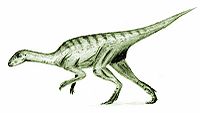 |
|
| Callovosaurus Callovosaurus Callovosaurus is a genus of iguanodontian dinosaur known from most of a left thigh bone discovered in Middle Jurassic-age rocks of England. At times, it has been considered dubious or a valid genus of basal iguanodontian, perhaps a dryosaurid.-History and description:Callovosaurus is based on... |
England | A primitive camptosaurid iguanodont Iguanodont Iguanodonts were herbivorous dinosaurs that lived from the mid-Jurassic to Late Cretaceous. Some members include Camptosaurus, Callovosaurus, Iguanodon, Ouranosaurus, and the hadrosaurids or "duck-billed dinosaurs". Iguanodonts were one of the first groups of dinosaurs to be found... , estimated to have been 3.5 meters long |
||
| Ferganocephale Ferganocephale Ferganocephale was possibly an early pachycephalosaurian dinosaur. It was from the Middle Jurassic of Kyrgyzstan.The type species, Ferganocephale adenticulatum, was first described by Averianov, Martin, and Bakirov in 2005, and is based solely on teeth from the Callovian. The holotype is ZIN PH... |
Kyrgyzstan | Possibly an early pachycephalosaurid | ||
| Hexinlusaurus Hexinlusaurus Hexinlusaurus is a genus of basal ornithischian dinosaur from the Middle Jurassic of China. The holotype , consists of an almost complete, articulated skull and some postcranial material, collected from a terrestrial sandstone within the Lower Shaximiao Formation at the famous dinosaur-bearing...
|
Bathonian Bathonian In the geologic timescale the Bathonian is an age or stage of the Middle Jurassic. It lasted from approximately 167.7 Ma to around 164.7 Ma... to Callovian |
Lower Shaximiao Formation, Sichuan, China | A small ornithischian dinosaur distinguished from all other basal ornithischians by a single autapomorphy, the presence of a marked concavity that extends over the lateral surface of the postorbital. | |
†Plesiosaurs
| Plesiosaurs of the Callovian | ||||
|---|---|---|---|---|
| Taxa | Presence | Location | Description | Images |
| Liopleurodon Liopleurodon Liopleurodon is a genus of large, carnivorous marine reptile belonging to the Pliosauroidea, a clade of short-necked plesiosaurs. Two species of Liopleurodon lived during the Callovian stage of the Middle Jurassic Period , while the third, L. rossicus, lived during the Late Jurassic... |
 |
|||
| Pachycostasaurus Pachycostasaurus Pachycostasaurus is an extinct genus of plesiosaur.... |
||||
| Peloneustes Peloneustes Peloneustes is an extinct genus of sauropterygian reptile belonging to the family Pliosauridae. It is known from the Callovian aged deposits of the Oxford clay formation of England... |
 |
|||
| Pliosaurus Pliosaurus Pliosaurus is a genus of extinct marine reptile. It is included in the family Pliosauridae. Its diet would have included fish, squid and other marine reptiles. This genus has contained several species in the past but it currently consists of the type species P. brachydeirus, P. macromerus and P... |
 |
|||
| Simolestes Simolestes Simolestes is an extinct genus of pliosaurs that lived in the Middle to Late Jurassic. Three species are currently known:*Simolestes keileni from the Bajocian of France... |
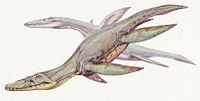 |
|||
†Sauropods
| Sauropods Sauropoda Sauropoda , or the sauropods , are an infraorder of saurischian dinosaurs. They had long necks, long tails, small heads , and thick, pillar-like legs. They are notable for the enormous sizes attained by some species, and the group includes the largest animals to have ever lived on land... of the Callovian |
||||
|---|---|---|---|---|
| Taxa | Presence | Location | Description | Images |
| Abrosaurus Abrosaurus Abrosaurus is a genus of macronarian sauropod dinosaur from the Middle Jurassic Period of what is now Asia, one of many dinosaurs found at the Dashanpu Quarry in the Sichuan Province of China. Like most sauropods, Abrosaurus was a quadrupedal herbivore but it was rather small for a sauropod, not... |
Abrosaurus was a small (30 foot adult length) sauropod from China China Chinese civilization may refer to:* China for more general discussion of the country.* Chinese culture* Greater China, the transnational community of ethnic Chinese.* History of China* Sinosphere, the area historically affected by Chinese culture... with an unusual skull. |
|||
| Atlasaurus Atlasaurus Atlasaurus was a moderately large genus of sauropod dinosaur from Middle Jurassic beds in North Africa.-Discovery and species:Atlasaurus was discovered by Monbaron, Russell & Taquet in 1999... |
||||
Ferganasaurus
|
A Kyrgistani sauropod genus that resembled Rhoetosaurus Rhoetosaurus Rhoetosaurus , named after Rhoetus, a titan in Greek Mythology, is a genus of sauropod dinosaur from the Jurassic of what is now eastern Australia. Rhoetosaurus is estimated to have been about 12–15 metres long... . |
|||
| Patagosaurus Patagosaurus Patagosaurus was a large herbivorous dinosaur from the long-necked group Sauropoda. It reached a length of 18 meters. Similar to other primitive eusauropods, it was rather heavily built and similar to Cetiosaurus in general appearance. It is known from a dozen individuals, though some referred... |
||||
†Stegosauria
| Stegosaurs of the Callovian | ||||
|---|---|---|---|---|
| Taxa | Presence | Location | Description | Images |
| Huayangosaurus Huayangosaurus Huayangosaurus is a genus of stegosaurian dinosaur from the Middle Jurassic of China. The name derives from "Huayang", an alternate name for Sichuan , and "saurus", meaning "lizard"... |
Bathonian Bathonian In the geologic timescale the Bathonian is an age or stage of the Middle Jurassic. It lasted from approximately 167.7 Ma to around 164.7 Ma... to Callovian |
Lower Shaximiao Formation, Sichuan, China | A 4.5 meters in length quadrupedal herbivore with a small skull and a spiked tail. Bore the distinctive double row of plates, rising vertically along its arched back, of all the stegosaurians and two pairs of long spikes extending horizontally near the end of its tail |  |
| Lexovisaurus Lexovisaurus Lexovisaurus was one of the first dinosaurs from mid-to-Late Jurassic Europe, 164.7 mya to be discovered. It was a stegosaur. Its fossils have been found in France and northern England.... |
Lisieux, France; Northern England | Traditionally, Lexovisaurus was depicted as having either large spines over the hips or shoulders, with a selection of flat plates and round pointed spines that ran along the back and tail. It was probably about 5 m long. | ||
| Loricatosaurus Loricatosaurus Loricatosaurus is a genus of stegosaurid dinosaur from Callovian-age rocks of England and France... |
France; England | Known from remains previously assigned to Lexovisaurus. | ||
Theropods
| Theropods Theropoda Theropoda is both a suborder of bipedal saurischian dinosaurs, and a clade consisting of that suborder and its descendants . Dinosaurs belonging to the suborder theropoda were primarily carnivorous, although a number of theropod groups evolved herbivory, omnivory, and insectivory... of the Callovian |
||||
|---|---|---|---|---|
| Taxa | Presence | Location | Description | Images |
| Eustreptospondylus Eustreptospondylus Eustreptospondylus is a genus of megalosaurid dinosaur, from the Callovian stage of the Middle Jurassic period in southern England, at a time when Europe was a series of scattered islands Eustreptospondylus ("well-curved vertebra", in reference to the arrangement of the spine in the original... |
A moderately large (17-23 feet long) predatory dinosaur that was closely related to Megalosaurus Megalosaurus Megalosaurus is a genus of large meat-eating theropod dinosaurs of the Middle Jurassic period of Europe... . |
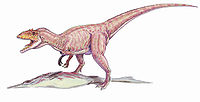 |
||
| Gasosaurus Gasosaurus Gasosaurus was a tetanuran dinosaur discovered in Dashanpu, China. The scientific name, meaning "Gas Lizard", honours the gasoline company that found the Dashanpu fossil quarry in Sichuan Province, now named as the Lower Shaximiao Formation. It had strong legs but short arms, and like most...
|
An 11-13 foot predator from China China Chinese civilization may refer to:* China for more general discussion of the country.* Chinese culture* Greater China, the transnational community of ethnic Chinese.* History of China* Sinosphere, the area historically affected by Chinese culture... whose discovery was assisted by the petroleum Petroleum Petroleum or crude oil is a naturally occurring, flammable liquid consisting of a complex mixture of hydrocarbons of various molecular weights and other liquid organic compounds, that are found in geologic formations beneath the Earth's surface. Petroleum is recovered mostly through oil drilling... industry. |
|||
| Pedopenna Pedopenna Pedopenna is a genus of small, feathered, maniraptoran dinosaur from the Daohugou Beds in China. It is possibly older than Archaeopteryx, though the age of the Daohugou Beds where it was found is debated... |
||||
| Szechuanoraptor Szechuanoraptor "Szechuanoraptor" is the informal name given to an as yet undescribed genus of dinosaur from the Middle Jurassic . It was a theropod which lived in what is now China... |
A Chinese China Chinese civilization may refer to:* China for more general discussion of the country.* Chinese culture* Greater China, the transnational community of ethnic Chinese.* History of China* Sinosphere, the area historically affected by Chinese culture... theropod that has yet to be formally described. |
|||
†AmmonitidaAmmonitidaThe Ammonitida is an order of more highly evolved ammonoid cephalopods from the Jurassic and Cretaceous time periods, commonly with intricate ammonitic sutures....
Members of the Order Ammonitida are known as ammonitic ammonites. They are distinguished primarily by their sutureSuture (anatomical)
In anatomy, a suture is a fairly rigid joint between two or more hard elements of an animal, with or without significant overlap of the elements....
lines. In ammonitic suture patterns, the lobes and saddles are much subdivided (fluted) and subdivisions are usually rounded instead of saw-toothed. Ammonoids of this type are the most important species from a biostratigraphical point of view. This suture type is characteristic of Jurassic
Jurassic
The Jurassic is a geologic period and system that extends from about Mya to Mya, that is, from the end of the Triassic to the beginning of the Cretaceous. The Jurassic constitutes the middle period of the Mesozoic era, also known as the age of reptiles. The start of the period is marked by...
and Cretaceous
Cretaceous
The Cretaceous , derived from the Latin "creta" , usually abbreviated K for its German translation Kreide , is a geologic period and system from circa to million years ago. In the geologic timescale, the Cretaceous follows the Jurassic period and is followed by the Paleogene period of the...
ammonoids but extends back all the way to the Permian
Permian
The PermianThe term "Permian" was introduced into geology in 1841 by Sir Sir R. I. Murchison, president of the Geological Society of London, who identified typical strata in extensive Russian explorations undertaken with Edouard de Verneuil; Murchison asserted in 1841 that he named his "Permian...
.
| Ammonites of the Callovian | ||||
|---|---|---|---|---|
| Taxa | Presence | Location | Description | Images |
| Cadomites Cadomites Cadomites is an extinct ammonite genus from the superfamily Stephanocerataceae that lived during the Jurassic Period, which lasted from approximately 200 to 145 million years ago.... |
||||
| Oecoptychius Oecoptychius Oecoptychius is an extinct genus from a well known subclass of fossil cephalopods, the ammonites. It lived during the Jurassic Period, which lasted from approximately 200 to 145 million years ago.... |
||||
| Oecotraustes Oecotraustes Oecotraustes is an extinct genus from a well known subclass of fossil cephalopods, the ammonites. It lived during the Jurassic Period, which lasted from approximately 200 to 145 million years ago.... |
||||
| Oxycerites Oxycerites Oxycerites is an extinct ammonoid cephalopod belonging to the haploceratacean family, Oppeliidae, that lived during the middle of the Jurassic Period, between 164 and 160 million years ago... |
||||
| Peltoceras Peltoceras Peltoceras is an extinct ammonite genus from the aspidoceratid subfamily Peltoceratinae that lived during the later part of the Middle Jurassic .... |
||||
†Belemnites
| Belemnites of the Callovian | ||||
|---|---|---|---|---|
| Taxa | Presence | Location | Description | Images |
| Produvalia Produvalia Produvalia is a genus of belemnite, an extinct group of cephalopods.... |
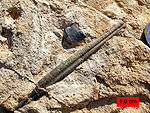 |
|||
Nautiloids
| Nautiloids of the Callovian | ||||
|---|---|---|---|---|
| Taxa | Presence | Location | Description | Images |
| Somalinautilus | 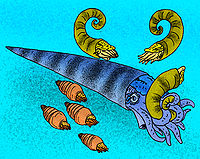 |
|||
Neocoleoids
| Neocoleoidea Neocoleoidea Neocoleoidea is a large group of marine cephalopods. This cohort contains two extant groups: Decapodiformes and Octopodiformes . Species within this group exist in all major habitats in the ocean, in both the southern and northern polar regions, and from intertidal zones to great depths... of the Callovian |
||||
|---|---|---|---|---|
| Taxa | Presence | Location | Description | Images |
Proteroctopus
|
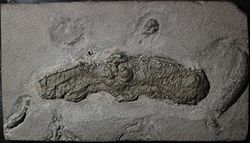 |
|||
| Rhomboteuthis
Rhomboteuthis lehmani Rhomboteuthis lehmani is an extinct species of squid, currently the only described member of its genus. R. lehmani is known from the Lower Callovian of Voulte-sur-Rhône, Ardèche, France.... |
A squid species discovered in France France The French Republic , The French Republic , The French Republic , (commonly known as France , is a unitary semi-presidential republic in Western Europe with several overseas territories and islands located on other continents and in the Indian, Pacific, and Atlantic oceans. Metropolitan France... . |
|||
| Vampyronassa
Vampyronassa rhodanica Vampyronassa rhodanica is an extinct vampyromorph cephalopod known from around 20 fossils from the Lower Callovian of La Voulte-sur-Rhône, Ardèche, France.... |
||||
Literature
; 2002: Histoire de la Terre, Dunod, Paris (2nd ed.), ISBN 2-10-006631-5. ; 2004: A Geologic Time Scale 2004, Cambridge University PressCambridge University Press
Cambridge University Press is the publishing business of the University of Cambridge. Granted letters patent by Henry VIII in 1534, it is the world's oldest publishing house, and the second largest university press in the world...
.; 1842: Paléontologie française. 1. Terrains oolitiques ou jurassiques. 642 p, Bertrand, Paris.
External links
- GeoWhen Database - Callovian
- Jurassic-Cretaceous timescale, at the website of the subcommission for stratigraphic information of the ICS
- Stratigraphic chart of the Upper Jurassic, at the website of Norges Network of offshore records of geology and stratigraphy

